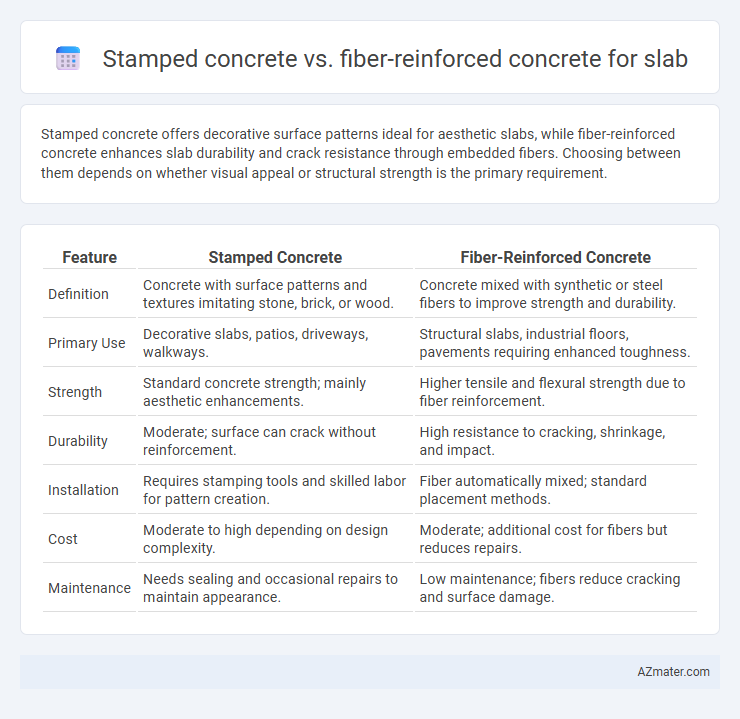Stamped concrete offers decorative surface patterns ideal for aesthetic slabs, while fiber-reinforced concrete enhances slab durability and crack resistance through embedded fibers. Choosing between them depends on whether visual appeal or structural strength is the primary requirement.
Table of Comparison
| Feature | Stamped Concrete | Fiber-Reinforced Concrete |
|---|---|---|
| Definition | Concrete with surface patterns and textures imitating stone, brick, or wood. | Concrete mixed with synthetic or steel fibers to improve strength and durability. |
| Primary Use | Decorative slabs, patios, driveways, walkways. | Structural slabs, industrial floors, pavements requiring enhanced toughness. |
| Strength | Standard concrete strength; mainly aesthetic enhancements. | Higher tensile and flexural strength due to fiber reinforcement. |
| Durability | Moderate; surface can crack without reinforcement. | High resistance to cracking, shrinkage, and impact. |
| Installation | Requires stamping tools and skilled labor for pattern creation. | Fiber automatically mixed; standard placement methods. |
| Cost | Moderate to high depending on design complexity. | Moderate; additional cost for fibers but reduces repairs. |
| Maintenance | Needs sealing and occasional repairs to maintain appearance. | Low maintenance; fibers reduce cracking and surface damage. |
Introduction to Stamped Concrete and Fiber-Reinforced Concrete
Stamped concrete enhances slab surfaces with patterned textures that mimic natural materials like stone or brick, offering durability and aesthetic appeal for patios, driveways, and walkways. Fiber-reinforced concrete incorporates synthetic or steel fibers into the mix, significantly improving slab tensile strength, crack resistance, and durability under heavy loads. Both materials serve distinct structural and decorative purposes in slab construction, combining functional resilience with architectural design.
Composition and Material Differences
Stamped concrete incorporates a blend of cement, sand, aggregate, and color additives, with surface treatments to mimic stone or brick patterns, emphasizing aesthetic versatility. Fiber-reinforced concrete integrates synthetic or steel fibers within the cement matrix to enhance tensile strength, crack resistance, and durability, prioritizing structural performance. The key material difference lies in stamped concrete's decorative surface focus versus fiber-reinforced concrete's internal fiber inclusion for mechanical enhancement.
Installation Process Comparison
Stamped concrete installation involves pouring a concrete slab, followed by color application, texturing with molds, and sealing, requiring skilled labor for precise pattern alignment and timing. Fiber-reinforced concrete simplifies the process by integrating synthetic or steel fibers into the mix before pouring, enhancing durability and reducing cracking without altering standard finishing steps. Installation of fiber-reinforced slabs generally demands less specialized finishing work compared to stamped concrete, resulting in faster project completion and lower labor costs.
Aesthetic Appeal and Design Flexibility
Stamped concrete offers high aesthetic appeal with customizable patterns, colors, and textures that mimic natural materials like stone, brick, or wood, enhancing design flexibility for decorative slabs. Fiber-reinforced concrete primarily enhances structural integrity and durability but provides limited design versatility, as its appearance remains consistent with standard concrete finishes. Choosing stamped concrete optimizes visual impact for slabs, while fiber-reinforced concrete supports performance without compromising structural resilience.
Structural Performance and Durability
Stamped concrete offers moderate structural performance with aesthetic surface patterns but lacks the enhanced tensile strength provided by fiber-reinforced concrete, which incorporates synthetic or steel fibers to improve crack resistance and load-bearing capacity. Fiber-reinforced concrete slabs demonstrate superior durability, exhibiting greater resistance to cracking, impact, and heavy traffic wear, making them ideal for industrial and high-stress applications. While stamped concrete excels in decorative appeal with customizable textures and colors, fiber-reinforced concrete provides a more robust, long-lasting solution for structural slabs requiring enhanced mechanical properties.
Crack Resistance and Longevity
Stamped concrete offers aesthetic appeal with moderate crack resistance, relying on surface treatments that may wear over time, whereas fiber-reinforced concrete significantly enhances crack resistance through internal reinforcement using synthetic or steel fibers, improving slab durability. Fiber-reinforced slabs exhibit superior longevity by distributing stress and minimizing shrinkage cracks, making them ideal for high-traffic or load-bearing applications. In contrast, stamped concrete slabs require regular maintenance to preserve appearance and prevent surface deterioration, potentially shortening their lifespan compared to fiber-reinforced alternatives.
Maintenance Requirements
Stamped concrete requires regular sealing every 2-3 years to prevent cracks and maintain its decorative finish, while fiber-reinforced concrete offers enhanced durability that reduces surface cracking and minimizes maintenance efforts. Fiber-reinforced concrete slabs benefit from improved tensile strength and crack resistance due to the embedded fibers, which reduces repair frequency and costs over time. In contrast, stamped concrete, though visually appealing, demands ongoing maintenance to preserve its appearance and structural integrity under heavy traffic or environmental stress.
Cost Analysis: Upfront and Long-Term
Stamped concrete typically incurs higher upfront costs due to intricate patterns and texturing techniques, while fiber-reinforced concrete for slabs presents moderate initial expenses with enhanced structural benefits. Over the long term, fiber-reinforced concrete reduces maintenance and repair costs by improving crack resistance and durability, whereas stamped concrete may require periodic resealing and repairs to maintain aesthetic appeal. Cost analysis favors fiber-reinforced concrete for slabs where long-term savings and structural integrity are prioritized.
Best Applications for Each Type
Stamped concrete excels in decorative applications such as patios, walkways, and driveways where aesthetic appeal mimicking stone, brick, or wood is desired. Fiber-reinforced concrete is ideal for structural slabs, industrial floors, and parking decks requiring enhanced tensile strength, crack resistance, and durability. Choosing the right type depends on whether visual design or load-bearing performance is the primary requirement.
Choosing the Right Concrete for Your Slab Project
Stamped concrete offers decorative appeal with customizable patterns and colors, ideal for enhancing visual aesthetics of slabs in patios and walkways. Fiber-reinforced concrete improves structural strength and crack resistance, making it a practical choice for slabs requiring durability and load-bearing capacity. Selecting between stamped and fiber-reinforced concrete depends on balancing design preferences with performance needs for your specific slab project.

Infographic: Stamped concrete vs Fiber-reinforced concrete for Slab
 azmater.com
azmater.com